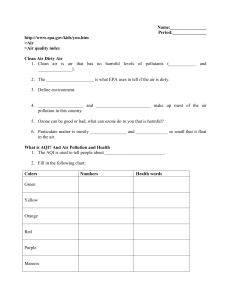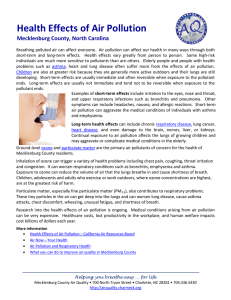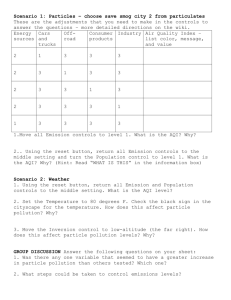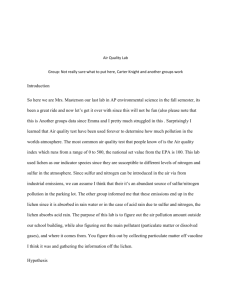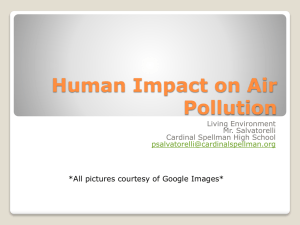Where Does Air Pollution Come From? + What
advertisement
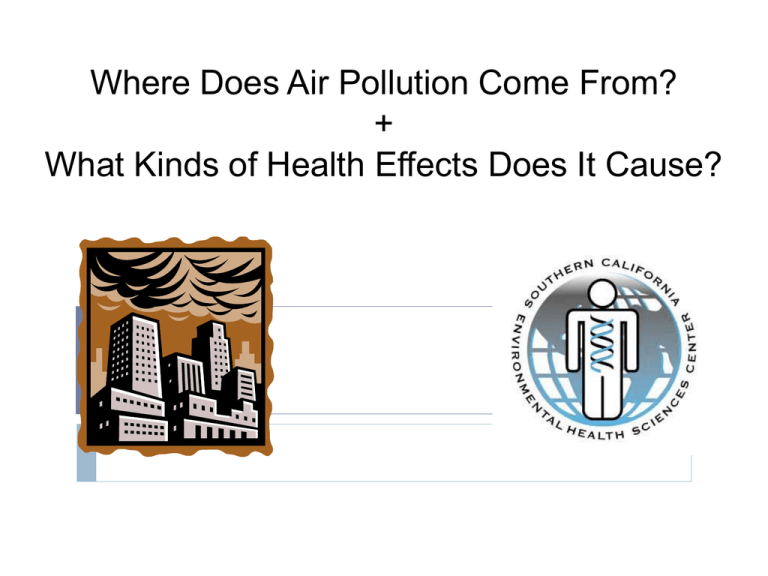
Where Does Air Pollution Come From? + What Kinds of Health Effects Does It Cause? What is Air Pollution? Particles or gases in the air that are not part of the normal composition of air “Smog” is visible air pollution Many pollutants, including some of the most dangerous, are invisible Where Does Air Pollution Come From? Human-made pollution Burning fuel Such as coal, oil, wood, and other fuels to power vehicles (ships, trains, trucks, cars) Industrial activity Power plants, factories Two Major Sources of Air Pollution Stationary sources Mobile sources Important Air Pollutants Ozone (O3) Particulate Matter (PM) Carbon Monoxide (CO) Nitrogen Oxides (NO) Sulfur Dioxide (SO2) Lead (Pb) Ozone (O3) (Smog) + Emissions = Sunlight (Photochemical reaction) Ozone - good up high, bad nearby Ozone (smog) Lungs & OZONE It’s like getting a sunburn in your lungs Particulate matter Particulate Matter Particles that float in the air Created by burning fuel also dust and pollen Particulate Matter 10 to 100 times smaller than the width of a human hair! Cross Section of a Human Hair PM 10 PM 2.5 Ultrafine PM • This stuff is the most dangerous! Particles in the Body Particles travel with the air people breathe into the respiratory system The larger a particle is, the more likely it is to get stuck in the body’s first defenses The smaller a particle is, the more likely it is to travel on to the lungs Ultrafine particles (the tiniest) can get into the bloodstream and move to other organs Lungs & particulate matter Routes of entry into the body Breathing in, eating, absorb through the skin In the lungs, pollution can directly damage the lung tissue causing illness or disease From the lungs, they can get into the bloodstream and be transported to organs throughout the body Air Pollution Health Effects Acute and chronic effects Acute effects like itchy eyes Premature babies (born earlier than they should be) Heart disease Cancer USC Children’s Health Study Children are more vulnerable to air pollution In the more polluted communities, children have: More doctors’ visits More missed school days Reduced lung growth and function Makes asthma worse More new cases of asthma near freeways What can we do about it? It’s as easy as 1, 2, 3… 1. Protect ourselves 2. Try to pollute less 3. Take action to stop air pollution Air Quality Index Lets you know when it is a high pollution day Stay inside to reduce risk when AQI is at 100 or higher AQI can be found in newspapers, TV, radio, internet www.AirNow.gov Air Quality Index (AQI) Values Levels of Health Concern When the AQI is in this range: ...air quality conditions are: 0 to 50 Good 51 to 100 Moderate 101 to 150 Unhealthy for Sensitive Groups 151 to 200 Unhealthy 201 to 300 Very Unhealthy 301 to 500 Hazardous Polluting less Carpool Ride your bike or walk Take the bus Use vehicles and equipment that is well maintained or electric Take Action Teach others about what you have learned Tell government agencies that you want clean air Credits Presentation created by Carla Truax, through the Southern California Environmental Health Sciences Center and the Trade, Health, and Environment Impact Project Selected graphics (including lung animation): Carolina Simunovic & Fresno Metro Ministries Photos: Andrea Hricko, Carolina Simunovic, and Communities for a Better Environment
